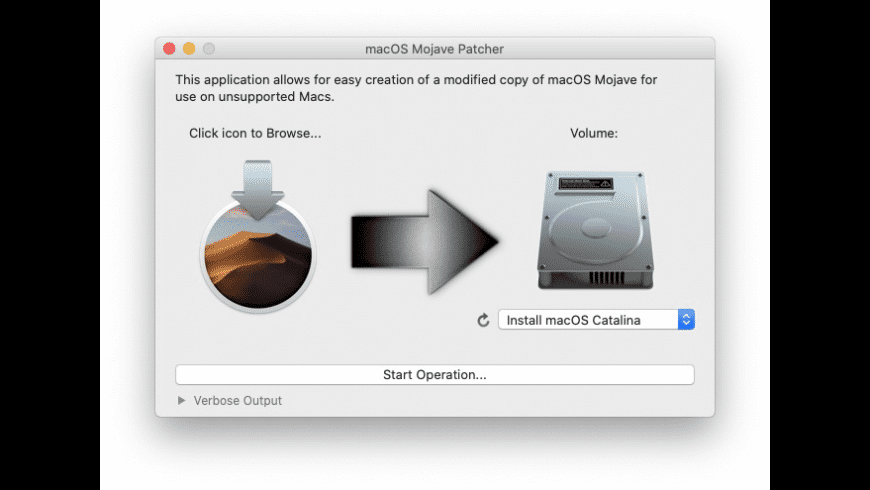R/MojavePatcher: macOS Mojave 10.14 on unsupported Macs (Credit goes to dosdude1, ASentientBot, julianfairfax, and others). Mac Os Mojave Patcher; Today I will tell you how to install macOS Mojave or other fresh macOS on an unsupported Mac using the Mojave Patcher Tool. This utility is available for free. You can see more information and patcher updates here on a dosdude site. You carry out all actions with the computer and the program at your own peril and risk! Guide for Mojave (Also the patcher download page) Guide for Catalina (Also the patcher download page) When you done with the patcher you can comeback to this page again for the next step. Installing macOS Mojave/Catalina. To install macOS Mojave or Catalina you can choose to doing a clean install or doing a direct upgrade.
 Updates
UpdatesImportant Notes:
- Using APFS is REQUIRED in Mojave in order to receive system updates via the normal Software Update method. If you choose to continue using macOS Extended (Journaled) as your filesystem type, you will NOT receive System Updates via System Preferences. If you are not using APFS, you can follow the 10.14.1 installation steps below.
- After applying ANY system update via Software Update, re-applying post-install patches using your Mojave Patcher installer volume will most likely be necessary. If you install a software update and the system fails to boot afterwards, this is what needs to be done.
10.14.6
10.14.6 can be updated normally via Software Update if using an APFS volume, and will need to be patched using an installer volume created with Mojave Patcher version 1.3.2 or later after installing.
10.14.5
10.14.5 can be updated normally via Software Update if using an APFS volume, and will need to be patched using an installer volume created with Mojave Patcher version 1.3.1 or later after installing.
10.14.4
10.14.4 adds new changes that ARE NOT patchable by the post-install tool of Mojave Patcher v1.2.3 and older! Before updating to 10.14.4, you you will need to use the latest Mojave Patcher version to create a new installer volume, using the 10.14.4 installer app. Then, update to 10.14.4, either by installing via Software Update, or by just using the installer volume you've created to install.

10.14.3
If you are currently running 10.14.1 or 10.14.2, you can simply use the Software Update pane of System Preferences (if using APFS) to apply the 10.14.3 update. Once the update is installed, you will most likely need to re-apply post-install patches to get the system to boot again. This process is detailed in steps 8 - 10 above. If you are currently running 10.14.0, you'll need to proceed with the 10.14.1 update method described below.
10.14.2
If you are currently running 10.14.1, you can simply use the Software Update pane of System Preferences (if using APFS) to apply the 10.14.2 update. Once the update is installed, you will most likely need to re-apply post-install patches to get the system to boot again. This process is detailed in steps 8 - 10 above. If you are currently running 10.14.0, or are using a non-AFPS volume, you'll need to proceed with the 10.14.1 update method described below.
10.14.1/macOS Extended (Journaled) volumes
The Mojave 10.14.1 update does NOT install properly on unsupported machines, and could result in an unbootable OS. If you want to install the 10.14.1 update (and are not currently running 10.14.1), perform the following steps:
• Download the latest version of Mojave Patcher
• Download the installer using the Tools menu of Mojave Patcher
• Create a patched USB installer
• Boot from that, and install 10.14.1 onto the volume containing an older release.
• Once done, apply the post-install patches, and you should now be on 10.14.1.

Description:
Apple has finally released macOS 10.14, named Mojave after one of California's three deserts. If your organisation is itching to upgrade Mojave update to multiple Mac devices, the Upload Patch feature lets you perform the deployment efficiently.
System Requirements
You can upgrade your Mac operating system to Mojave 10.14, only if the following system requirements are met:

- Computer should be running on Mac 10.8 or later versions.
- A minimum of 18.5 GB free space is required on the hard disk.
- A minimum of 2 GB RAM memory is required.
- Mac Pro (mid 2010 and mid 2012 models) must first be updated to macOS High Sierra 10.13.6 before updating to macOS Mojave.
- You can refer this link for more details : MacOS 10.14 Mojave System Requirements.
Steps:
- Open App Store in one of the managed Mac devices.
- Click on the macOS Mojave icon and choose to download.
- Find the installation file 'Install macOS Mojave' in Applications folder by navigating to the file path /Applications/
- Compress the installation file using the following command
'tar -zcvf installMojave.tar.gz Install macOS Mojave.app/'
Note: The User should not execute the above command in some other directory. Go to the Applications folder(as mentioned in the file path) and execute that exact command in that folder to compress the installation file.
In order to deploy the macOS Mojave patch to Mac devices missing the latest version, it is required to upload the installation file to our patch store using the following steps:
(Note: This option is only available for the build 10.0.282 and above).
Mojave Patcher Dosdude
- Navigate to Patches > Downloaded patches > upload patches.
- Here you will find a list of patches that have to be downloaded manually. Apply the filter 'Missing patches in the network' and find the 'Upgrade to macOS Mojave' option under 'Patch Description'.
- Select Upload option.
- Navigate to the location of the downloaded patch file in and upload it.
- Now, the patch will be successfully uploaded to the patch store, and will be available for deployment.
Macos Patcher Mojave Free
Using our Install Patch configuration, you can deploy the Mojave update to all the Mac devices in your network.